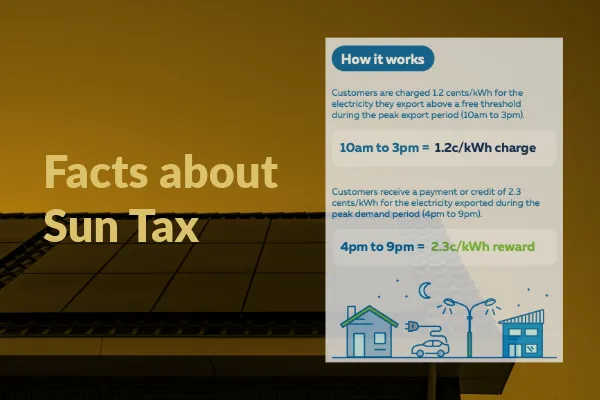Solar & Energy News

Understanding the Sun Tax: Two-Way Pricing with Solar
As solar energy adoption continues to grow, so does the complexity of electricity billing. One of the recent developments in this area is the introduction of two-way tariffs by electricity networks like Ausgrid. This blog post will explore the impact of two-way tariffs on your power bill, comparing scenarios with and without solar energy.
The Concept of Two-Way Tariffs
A two-way tariff is a pricing structure that includes both charges and credits for customers who generate their own electricity, such as those with solar panels. This is different from the traditional feed-in tariffs, which typically only provide credits for the electricity exported to the grid.
Under the two-way tariff, customers incur charges for the use of the network but also receive credits for the energy they export. This new structure aims to better reflect the costs and benefits of distributed energy resources on the electricity network.

The Financial Impact on Solar Customers
If your electricity retailer fully passes through the two-way pricing tariff, a typical 5 kW solar customer would see an annual bill increase of approximately $6.60. Here's a breakdown of this calculation:
Annual Charges: $13.30
Annual Export credit: $6.70
Net Impact: $13.30 (charges) - $6.70 (credit) = $6.60 (annual increase)
Comparing Bills: With and Without Solar
Let's look at the difference in power bills for customers with and without solar energy, under the assumption that the retailer fully passes through the two-way tariff.
Customer Without Solar
A typical customer without solar energy will have a bill that includes:
Generation costs
Transmission costs
Network charges
Green scheme costs
Retail costs
Since these customers do not generate their own electricity, they do not receive any export credits. Their bill reflects the total cost of electricity consumed from the grid.
Customer With Solar
A customer with a 5 kW solar system under the two-way tariff will have a bill that includes:
Reduced generation costs (due to self-consumption of solar energy)
Reduced transmission costs (for the same reason)
Network charges (including the two-way tariff)
Green scheme costs
Retail costs
Export credits
Even with the two-way tariff charges, solar customers benefit from reduced overall energy consumption from the grid and receive export credits, which can offset some of the costs.
The Role of Retailers
It's important to note that small customer electricity bills don’t show network charges separately. Our charges are bundled with other energy supply costs. Retailers may pass on the two-way tariff through changes in feed-in tariffs, likely reducing them during certain hours and increasing them during others. This dynamic pricing encourages customers to time their energy exports when it's most beneficial for the network.
Practical Implications for Solar Customers
Slight Increase in Bills: As mentioned, a typical 5 kW solar customer might see an annual increase of $6.60 in their bill due to the two-way tariff.
Optimising Export Timing: To maximise financial benefits, solar customers should aim to export energy during hours when feed-in tariffs are higher.
Investing in Storage: Using battery storage systems can help store excess energy produced during the day for use during peak times, optimising self-consumption and minimising charges.
Conclusion
The introduction of two-way tariffs represents a shift towards a more balanced and fair approach to managing distributed energy resources. While solar customers may see a slight increase in their annual bills, the overall benefits of generating and using renewable energy remain substantial. By understanding and adapting to these changes, customers can continue to enjoy the financial and environmental advantages of solar power.
Stay informed about your energy tariffs and make smart choices to optimize your energy usage and savings. Together, we can support a sustainable and efficient energy future.
For more info visit the following:
https://www.ausgrid.com.au/Connections/Solar-and-batteries/Solar-tariffs
Privacy Policy | © 2026 Lux Solar Pty Ltd

